
Mammillaria rhodantha on 7-19-16, #274-51.
Rainbow Pincushion
Mammillaria rhodantha
mam-mil-AR-ee-uh rho-DAN-tha
Synonyms of Mammillaria rhodantha… On 12-8-23 when this page was last updated, Plants of the World Online lists 142 synonyms. Normally, I would include the list but since there are so many you can click HERE to see them…
Mammillaria rhodantha Link & Otto is the correct and accepted scientific name of this plant. It was first described by Johann Heinrich Friedrich Link AND Christoph Friedrich Otto in Icones Plantarum Selectarum in 1828.
The genus, Mammillaria Haw., was named and described by Adrian Hardy Haworth in Synopsis Plantarum Succulentarum in 1812.
As of 12-8-23 when this page was last updated, Plants of the World Online by Kew lists 139 species in the Mammillaria genus. It is a member of the plant family Cactaceae with 150 genera. Those numbers could change as updates are made on POWO.
THERE ARE SEVERAL LINKS AT THE BOTTOM OF THE PAGE AND GROWING RECOMMENDATIONS FOR FURTHER READING.

Mammillaria rhodantha on 5-31-17, #339-33.
When I brought this plant from Walmart on February 1, 2016, the label just said Mammillaria species. I looked at a lot of photos online and on the Llifle (Encyclopedia of Life) website and could not figure it out. Finally, I sent an email and photos to Daiv Freeman of the CactuiGuide and he suggested it was a Mammillaria rhodantha. Even though the red spines would be a sure distinguishing feature, apparently I hadn’t looked at enough photos to get that far and so many mainly feature the flowers and not the spines. There are many red or brownish-red spined species of cactus in several other genera besides Mammillaria. But, of course, the tubercles and the way they are arranged are distinguishing characteristics of Mammillaria species. Plus, not all Mammillaria rhodantha have reddish spines… It’s complicated…

Mammillaria rhodantha on 9-5-17, #371-19.
Mammillaria rhodantha, commonly called Rainbow Pincushion, is a native of high-table lands in Queretaro, Michoacán, Zacatecas, Jalisco, and Hidalgo in Mexico where it grows in fertile soil. The population of the species is not listed as threatened or endangered.
It is a short columnar cactus that divides dichotomously to form colonies. It is a highly variable species that has led to many varieties, forms, and subspecies names that are now synonyms of Mammillaria rhodantha. Others have been accepted as separate species such as Mammillaria pringlei. Currently, Plants of the World Online does not list any accepted infraspecific (subspecies, varieties, or forms) names for Mammillaria rhodantha.

Mammillaria rhodantha bud on 9-27-17, #379-9.
One day in September I noticed it had a bud… It must have already been there for quite a while.

Mammillaria rhodantha on 10-11-17, #382-51.
As with all Mammillaria species, it is covered with tubercles that are arranged spirally around the cactus. The areoles at the tip of the tubercles produce from 16-24 white or yellowish radial spines that resemble stiff hair. On my plant, they seem to be 3/8” to 1/4” long and radiate around the areole. There are 4-6 straight to curved reddish-brown central spines that appear to be approximately 5/8” long (more or less). The areoles on top of the plant have a very small amount of wool but not on the rest of the plant. The axils between the tubercles also have wool on the top of the plant, more so around the apex, but also a little on the rest of the cactus as well. Mammillaria rhodantha f. cristata would be a very interesting monstrous form to have in a collection.

Mammillaria rhodantha at 3 3/4″ tall x 3″ wide on 10-17-17, #384-19.
Temperatures were getting cooler so I had to start thinking about bringing plants inside for the winter. You need to give your plants a good look before you bring them inside to make sure no bugs are coming in with them. Sometimes as cooler temps approach some insects may try to hibernate under leaves that have accumulated in the pot or around the base of the plant. I also measure my cacti and succulents periodically because some cacti grow so slowly that I like to measure them from time to time. On October 17, I moved the plants into the basement and the Mammillaria rhodantha measured 3 3/4″ tall x 3″ wide (including the spines). I usually don’t include the spines when I measure, but I kind of screwed up in 2017 and included the spines in the measurement. When I was finished cleaning, measuring, and taking photos I moved most of the plants upstairs for the winter.

Mammillaria rhodantha from the top showing many buds on 10-17-17, #384-20.
The Mammillaria rhodantha had a few more very small buds. Now, let’s see how long it takes for the flowers to open…

Mammillaria rhodantha on 10-31-17, #387-20.
I put several cactus and succulents on the kitchen windowsill where they receive a good amount of morning sun. The Mammillaria rhodantha was really glowing in the sun.

Mammillaria rhodantha on 11-6-17, #390-5.
I take a lot of photos but sometimes I don’t have a lot of words…
<<<<2018>>>>

Mammillaria rhodantha on the evening on 1-18-18, #401-10.
The potted plants and I are anxiously waiting for warmer weather…

Mammillaria rhodantha on 5-17-18, #443-62.
Finally, once warmer temperatures arrived I moved all the potted plants back outside for the summer.

Mammillaria rhodantha on 7-29-18, #487-69.
On July 4 in 2018 I had to relocate the tables I keep my plants on. We had a Japanese Beetle invasion and the plant tables were under a Chinese Elm tree which the beetles love. The beetles were beginning to sample the other plants so I put most of the cactus on the back porch and most of the succulents and other plants on the front porch. The back porch isn’t covered so the cactus will receive full sun. The Mammillaria rhodantha is beginning to grow a few buds again.

Mammillaria rhodantha on 8-26-18, #499-27.
By August 26 the buds were getting larger.

Mammillaria rhodantha at 4″ tall x 2 7/16″ wide on 10-10-18, #519-51.
I had to move the potted plants inside for the winter on October 10 because the forecast was calling for an “F” in a few days and the nighttime temperatures were getting cooler. I usually measure the cactus and succulents when I bring them inside and the Mammillaria rhodantha was 4″ tall x 2 7/16″ wide. Last year I messed up and included the spines in the measurement but this year I remembered not to.

Mammillaria rhodantha with flowers on 10-10-18, #519-52.
The Mammillaria rhodantha is a very admirable plant with its reddish central spines and white radial spines. It always looks great even without the flowers.
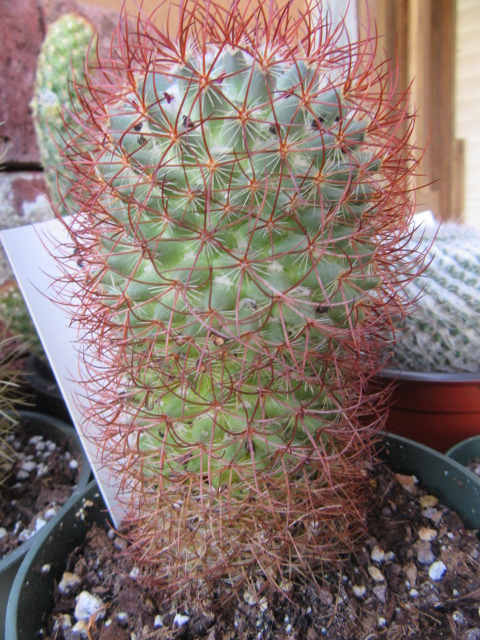
Mammillaria rhodantha on 11-29-18, #534-26.
November 29 was a nice spring-like day, so I took the cactus to the back porch for a photoshoot. I was working on a post to show the difference between the cactus in my collection. Sometimes I get busy and don’t pay much attention to the cactus and wonder what happened to the flowers… I notice buds earlier, then just small reddish dots later…
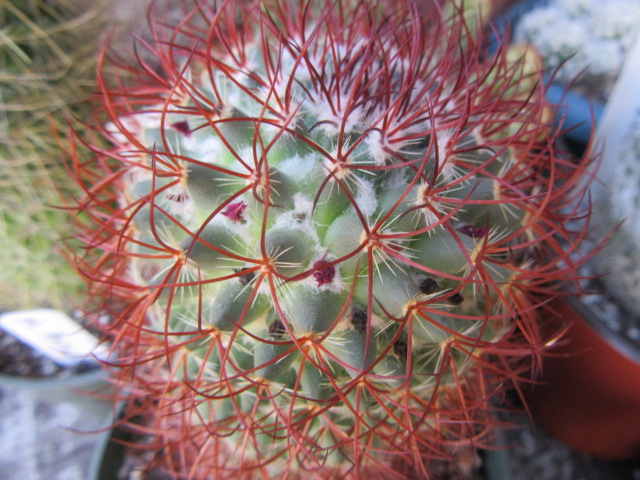
Mammillaria rhodantha buds on 11-29-18, #534-27.
It takes a LONG time for the buds to open on this plant… Buds form in the axils between the tubercles from the previous year’s growth. There is also a little wool in the axils between the tubercles which disappears with age. Supposedly, maybe on some species, flowering doesn’t occur until after the growth of trichomes becomes inactive. Here you see buds forming among the wool between some of the tubercles… Or maybe the flowers have already opened and now they are wilted…
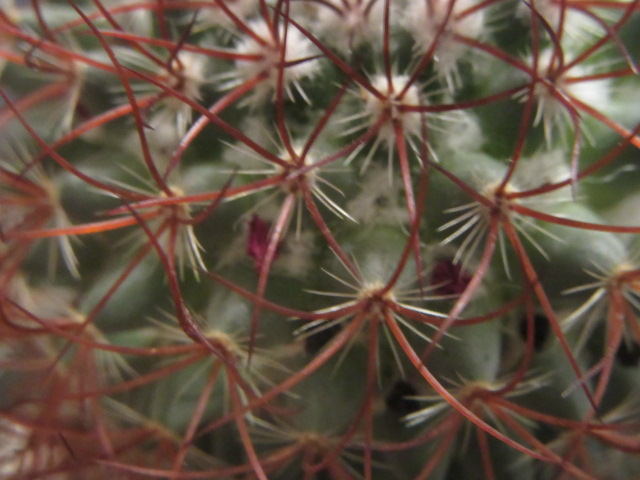
Mammillaria rhodantha close-up on 12-1-18, #535-20.
This Mammillaria rhodantha has 4-6 long, reddish-brown, recurving central spines. Other variations do not have reddish-brown spines. It produces 16-24 white (sometimes yellowish) radial spines.
The radial spines on the lower plant can turn somewhat gray looking with age, which Llifle says appears to be dying.
Mammillaria rhodantha divides dichotomously and also produces offsets. Hmmm… I didn’t realize I had so many Mammillaria species that divide dichotomously…
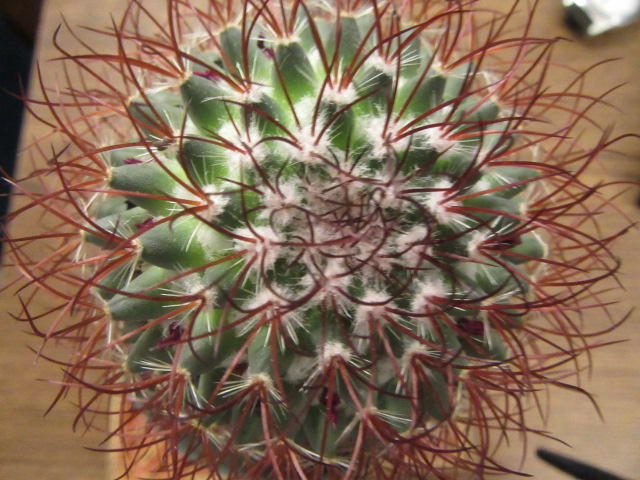
Mammillaria rhodantha from the top on 12-10-18, #538-1.
I took a photo of the top part of this cactus because it is very interesting. Many species have a wooly apex but the Mammillaria rhodantha is especially colorful. The wool on its areoles pretty much disappears as the plant ages.
<<<<2019>>>>

Mammillaria rhodantha on 6-22-19, #593-34.
Once evening temperatures warmed up I moved the potted plants back outside for the summer. I moved the cactus to the back porch where they could receive full sun.
I was fairly busy during the summer so I didn’t take many photos. All the plants did very well despite a little neglect.

Mammillaria rhodantha at 4 1/2″ tall x 2 1/2″ wide on 10-11-19, #639-73.
I had to bring the potted plants inside on October 11 because an “F” was in the forecast. I always take photos of the plants as I bring them inside and measure the cactus and some of the succulents. The Mammillaria rhodantha measured 4 1/2″ tall x 2 1/2″ wide.

Mammillaria rhodantha from the top on 10-19-19, #643-8.
Although this plant flowers several times over the summer and again in October, it doesn’t produce a lot of flowers. Mammillaria pringlei flowers in the same manner but produce A LOT of flowers. Mammillaria pringlei has been, and still is according to some, a subspecies of Mammillaria rhodantha. Well, I didn’t bring it home for the flowers. I brought it home because of its red spines…
<<<<2020>>>>

Mammillaria rhodantha (Rainbow Pincushion) at 4 1/4″ tall x 2 5/8″ wide on 10-15-20, #747-78.
I had to bring the potted plants inside on October 15 (2020) because an “F” was in the forecast. As always, I took photographs and measurements. The Mammillaria rhodantha did very well over the summer and measured 4 1/4″ tall x 2 5/8″ wide.

Mammillaria rhodantha (Rainbow Pincushion) from the top on 10-15-20, #747-79.
Lots of buds…
<<<<2021>>>>
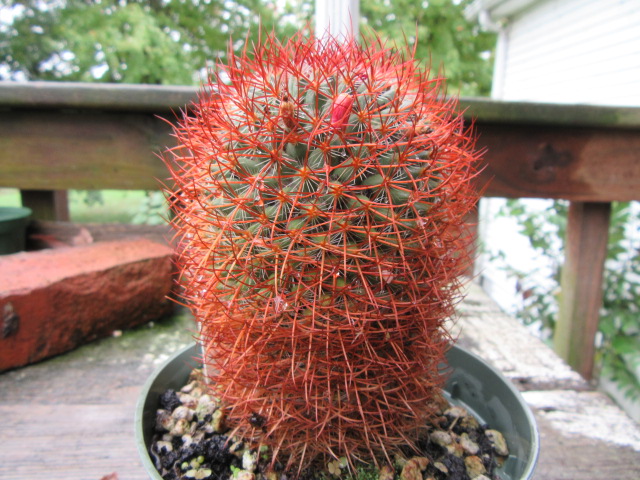
Mammillaria rhodantha (Rainbow Pincushion) at 4 1/8″ tall x 2 3/4″ wide on 10-28-21, #853-23.
I didn’t have to move the potted plants inside for the winter until October 28 in 2021. There wasn’t a chance of “F” in the forecast until then which was quite unusual. The Mammillaria rhodantha grew to 4 1/8″ tall x 2 3/4″ wide over the summer and has a few buds…
USEFUL INFORMATION:
Family: Cactaceae
Origin: Mexico
Zones: USDA Zones 9a-11 (20 to 40° F).
Size: 6-12” tall (15-30 cm).
Light: Sun to part shade.
Soil: Fast-draining. Potting soil amended with pumice or perlite and grit.
Water: Average during the growing period, barely if any during the winter.
Flowers: Pinkish flowers about any time of the year.
You can read my Cactus Talk & Update and Cactus & Succulent Tips to get my opinion about growing cactus and succulents.
When you bring your new plants home from the store, you need to check their roots and the soil to see if they are wet. If so, you may want to re-pot it right away. It is advisable to re-pot them in a better potting soil more suitable for cactus and succulents.
<<<<2022>>>>
Sorry to say, but both the Mammillaria rhodantha and Mammillaria pringlei didn’t make it through the winter. They had a small attack of mealybugs that I had to continually treat. Normally with cacti, all you have to do is use cotton swabs with alcohol and remove them or at least dab a little on the bugs. But the mealy bugs persisted. I used the same spray I have used in the past if I needed to, but in the end, both plants succumbed. I think it was the plants being treated constantly while they were dormant rather than the mealybugs that did them in. GEEZ! I hadn’t had any mealy bug issues until a couple of years ago after I received plants from an online store. Their plants were the first to have mealy bugs. Since then, I have had a few issues… You just never know…
In my opinion, the Mammillaria rhodantha was a great spiny companion and is very easy to grow. Mammillaria species, in general, are very popular because they do so well and come in a variety of shapes and sizes. Many species are readily available and one can get addicted to collecting them. Now I will have to find another one to replace it, but I think it may be very difficult to find one with red spines…
I will continue adding more photos and information as time goes by. The links below take you directly to information about the species, or genus, for further reading.
I hope you enjoyed this page and maybe found it useful. I would like to hear from you if you have any comments, questions, or suggestions. If you find an error, please let me know. I am not an expert. Please click on “like” if you visited this page. It helps us bloggers stay motivated. 🙂 If you wish, you can send an email to thebelmontrooster@yahoo.com.
Thank you so much for this post & detailed pictorial updates. I got a Rainbow Pincushion as a gift two months ago and I’ve been looking for something like this although this was super comprehensive which I loved to read. I’m going to measure mine and monitor for any updates. I live in the tropics where there’s no much seasonal change. Thanks again for this post.
LikeLiked by 1 person
Hello Sharone! I am glad to hear you have a Mammillaria rhodantha and hope it continues to do well for you. It is a really neat plant with the red spines. I am also glad you enjoyed the page. Take care and thanks for the comment.
LikeLike